Book contents
- Frontmatter
- Contents
- List of contributors
- Foreword
- Preface
- Part I What is life?
- Part II Astronomical and geophysical context of the emergence of life
- Part III The role of water in the emergence of life
- Part IV From non-living systems to life
- Part V Mechanisms for life evolution
- Part VI Life in extreme conditions
- 22 Life in extreme conditions: Deinococcus radiodurans, an organism able to survive prolonged desiccation and high doses of ionizing radiation
- 23 Molecular effects of UV and ionizing radiations on DNA
- 24 Molecular adaptations to life at high salt: lessons from Haloarcula marismortui
- Part VII Traces of life and biosignatures
- Part VIII Life elsewhere?
- Index
23 - Molecular effects of UV and ionizing radiations on DNA
from Part VI - Life in extreme conditions
Published online by Cambridge University Press: 04 February 2011
- Frontmatter
- Contents
- List of contributors
- Foreword
- Preface
- Part I What is life?
- Part II Astronomical and geophysical context of the emergence of life
- Part III The role of water in the emergence of life
- Part IV From non-living systems to life
- Part V Mechanisms for life evolution
- Part VI Life in extreme conditions
- 22 Life in extreme conditions: Deinococcus radiodurans, an organism able to survive prolonged desiccation and high doses of ionizing radiation
- 23 Molecular effects of UV and ionizing radiations on DNA
- 24 Molecular adaptations to life at high salt: lessons from Haloarcula marismortui
- Part VII Traces of life and biosignatures
- Part VIII Life elsewhere?
- Index
Summary
Introduction
Survival of microorganisms in outer space, such as resistant bacterial endospores, is affected by harsh environmental conditions including microgravity, space vacuum leading to desiccation, wide variations in temperature and a strong radiation component of both galactic and solar origins (Nicholson et al., 2000). Solar extraterrestrial UV radiation is mostly deleterious due to its UV component consisting of genotoxic UVC (200 < λ < 280 nm) and more energetic vacuum–UV photons (140 < λ < 200 nm) that are able to ionize biomolecules but exhibit very low penetrating features. The galactic cosmic radiation (CGR) is composed predominantly of high-energy protons (85%), electrons, α-particles and high-charge (Z) and energy (E) nuclei (HZE). In addition, solar particle radiation that mostly consists of protons with very small amounts of α-particles and HZE ions is emitted during solar wind and erratic solar flares (Nicholson et al., 2000; Cucinotta et al., 2008). UVC and UVB photons (280 < λ < 320 nm) are, in the absence of shielding, the main lethal components of space radiation. However, an efficient protection against molecular effects of UV radiations is likely to occur when spores are embedded in micrometeorites according to the scenario that has been proposed for allowing interplanetary or interstellar transfer of microorganisms (Mileikowsky et al., 2000; Nicholson et al., 2000). In contrast, under the latter conditions, protection of microorganisms against the damaging effects of CGR, and more precisely, of highly penetrating HZE particles, is at best very limited.
- Type
- Chapter
- Information
- Origins and Evolution of LifeAn Astrobiological Perspective, pp. 359 - 374Publisher: Cambridge University PressPrint publication year: 2011
- 5
- Cited by



